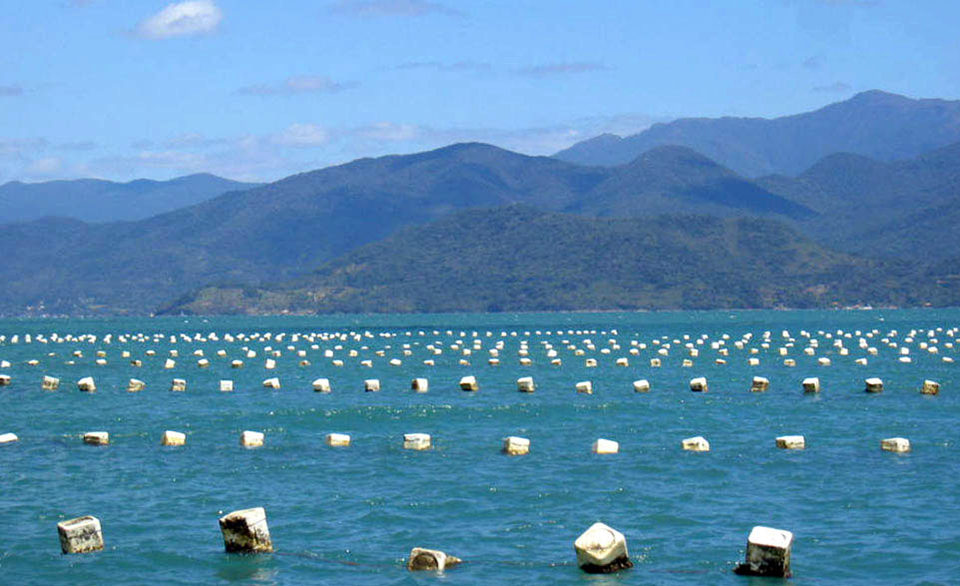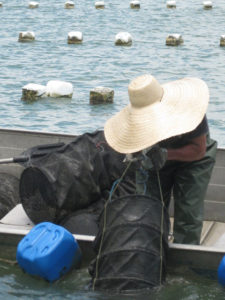Chlorophyll concentration effected phase duration in all the crops

Oyster production at a marine farm depends largely on three factors: oyster genetics, culture management and the environment. Although bivalve aquaculture is extremely dependent on the environmental features, most of the management procedures used by mariculture farms rely on previous understanding of the environmental characteristics of the farming site.
The effects of short-term changes in the farming environment are reflected in oyster harvests, so by understanding this relationship, it may be possible to improve farming management and output prediction. In order to do so, a study was developed joining commercial farming know-how with environmental assessment.
Oyster farm study
The collaborative study focused on the characterization of production data for Pacific cupped oysters (Crassostrea gigas) at the Atlântico Sul Marine Farm and further analysis in relation to events in the South Bay of Santa Catarina Island, where the farm is located in southern Brazil. The farm continually carries out self-initiated environmental studies and embraces partnerships with scientific projects to increase production and contribute to scientific development and improvements in mariculture in Brazil.
Four crops – years 2005-2006, 2006-2007, 2007-2008 and 2008-2009 – were studied. Three phases of oyster production were separately analyzed for each crop: seed to juvenile (phase 1), juvenile to adult (phase 2) and adult to marketable size (phase 3).
Production data
The mean culture time per crop in this region was approximately 16 months from initial seed stocking. Juvenile oysters grew to over 30 mm in size in 30 to 240 days after stocking. Adult oysters over 50 mm and marketable animals over 70 mm were regularly sorted after 60 to 450, and 150 to 510 days after seed stocking, respectively. The intermediate culture phase of juvenile to adult had the highest survival, followed by final growout. Due to the fragility of the smaller oysters, juveniles had the lowest survival rates. The mean final survival was around 30 percent.
Periods of El Niño bring high water temperatures to the South Bay of Santa Catarina Island. The water may only be cooled when a cold front occurs in the region. Since high water temperatures are related to lower survival of the farmed oysters, survival during periods of more intense El Niño were the lowest registered (32 percent in phase 1 and 70 percent in phase 2), whereas periods of more intense La Niña were characterized by higher survival percentages. See the values for phases 2 and 3 of the 2007-2008 and 2008-2009 crops in Table 1.
Mizuta, Production and survival of oysters, Table 1
| Crop | Seed Stocked | Juveniles Produced | Adults Produced | Marketable Oysters | Survival (%) Phase 1 | Survival (%) Phase 2 | Survival (%) Phase 3 | Survival (%) Final | Time (months) Phase 1 | Time (months) Phase 2 | Time (months) Phase 3 | Time (months) Final |
|---|---|---|---|---|---|---|---|---|---|---|---|---|
| 2005-2006 | 1,227,964 | 526,300 | 461,520 | 341,988 | 42.8 | 87.6 | 74.1 | 27.8 | 8 | 7 | 13 | 18 |
| 2006-2007 | 1,896,435 | 604,800 | 481,680 | 367,931 | 31.8 | 79.6 | 76.3 | 19.4 | 6 | 8 | 12 | 17 |
| 2007-2008 | 2,148,680 | 788,200 | 785,520 | 588,564 | 36.6 | 99.6 | 74.9 | 27.3 | 5 | 6 | 8 | 13 |
| 2008-2009 | 913,980 | 611,100 | 536,760 | 394,410 | 66.8 | 87.8 | 73.4 | 43.1 | 6 | 6 | 10 | 15 |
A regression analysis between total crop survival and culture phase survival indicated a significant correlation between the survival of early-stage oysters and the final production of the crop, indicating the importance of successful seeding and early culture.
Environmental influences

There was a relationship for the first two phases of culture between high temperatures and lower survivals, save the cases in which high chlorophyll concentrations helped minimize the negative effects of high temperatures. In fact, the chlorophyll a concentration had an important effect on the phase duration in all the crops. In general, the higher the food availability (assessed by chlorophyll concentration), the shorter the culture phase.
The maximum mean values of sea surface temperature obtained in March justified the 2005-2006 crop’s good final survival (similar to the 2007/2008 crop, whose culture period had better chlorophyll a values because of its late initial seeding in April), whereas all other crops were initially stocked in March, a less favorable period with generally warmer water conditions.
Seawater chlorophyll a concentrations after the passage of cold fronts did not show a fixed pattern. For example, from March 2005 until mid-2007, cold fronts did not greatly increase chlorophyll concentrations. The period between July 2006 and February 2007, however, saw an El Niño event. From August 2007 to June 2008, a period of La Niña occurrence, the cold front events increased the chlorophyll concentrations in the bay.
Periods of El Niño favor the upwelling of nutrient-rich South Atlantic central water to the south of Santa Catarina Island, but the upwelling does not always happen because sometimes the water does not reach the surface. In order for the water to enter the bay, it may be necessary for a cold front to combine with the upwelling event to push the waters into the bay.
On the other hand, in periods of La Niña, predominantly southerly winds spread the Plata plume northward and into the bay without any other event. The uncertainty of the first described process of water entrance to the bay may be the reason the chlorophyll levels did not increase during this period.
Perspectives
Although the management and real conditions of a commercial bivalve farm depend on various aspects, including market demand, study of the environmental conditions at each farming site is necessary to keep the long-term success of the activity based on possible short-term climate variability.
In the future, the choice of more suitable species for the local climate or stocking seed during the colder months might be alternatives to maintain the mariculture production in Santa Catarina. The present survey was helpful, but showed that more studies will be necessary in order to mitigate and find adaptive strategies that provide tools for further effective, responsible decision making for the industry.
(Editor’s Note: This article was originally published in the July/August 2011 print edition of the Global Aquaculture Advocate.)
Authors
-
Darien D. Mizuta
Fisheries and Environmental Aquaculture Laboratory
Kyoto University
Kyoto, Japan -
Nelson Silveira Júnior
Atlântico Sul Marine Farm
Florianópolis, Brazil -
Christine E. Fischer
Atlântico Sul Marine Farm
Florianópolis, Brazil -
Daniel Lemos
Aquaculture Laboratory
Oceanographic Institute
University of São Paulo
Praça do Oceanográfico 191
São Paulo, Brazil[114,98,46,112,115,117,64,115,111,109,101,108,108,101,100]
Tagged With
Related Posts

Responsibility
Ailing waterways hail the oyster’s return
The Lower Hudson Estuary and Chesapeake Bay, two waterways once home to thriving oyster beds, would welcome the shellfish’s return. Aquaculture initiatives in both areas aim to reinvigorate the water and the communities they support.

Health & Welfare
Artificial upwelling maintains favorable summer environment for farmed oysters
The summer season poses threats for oyster aquaculture worldwide. In addition to high mortality, poor oyster quality and health – especially in enclosed bays – are often attributed to water stratification, high temperatures and hypoxia.

Health & Welfare
Advice for managing predatory birds, part 2
A look at economic implications of predatory birds on commercial tilapia facilities, and the various control technologies – mostly non-lethal, such as frightening techniques – used by the industry to protect its farmed fish.

Intelligence
An emerging shellfish farming industry in Namibia
For shellfish farming in Namibia to continue expanding, industry must better comply with approved sanitation standards. The Namibian Shellfish Monitoring and Sanitation Program, currently in development, will help.


